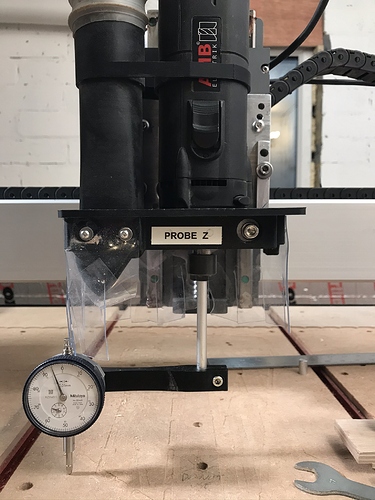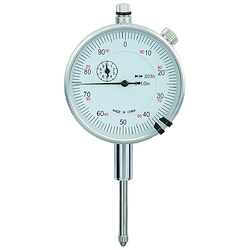It is really easy to go overboard on the measuring tools. Trust me. This is the voice of experience (does any one person really need six 1 micron precision test indicators?)
There is value to buying the best you can afford that meets your need, but, to be honest, for some things, the bargain units are fine. I have a mix from the least expensive no-name import to Mitutoyo, Starrett, B&S, and Interapid. The cheapies get a lot of use, and this reduces risk of damage to the more expensive ones.
Short answer: for tramming, get a 10mm range inexpensive standard dial indicator -with an actual needle, not electronic. (I don’t know what you have for suppliers, but in the US, Shars would be one option, or even Harbour Fright) It will be small enough to fit, large enough to see. If the ring is all one color (most are), color one side. Nail polish on the bezel is good for this. Makes it easy to see at a glance which way the needle is from zero, especially with a mirror.
Flat back or lug back is application dependent. I rarely use the lug back except on a bench instrument.
More detail than you want, probably:
Be careful of chasing too much precision. For a Shapoko, 0.01mm is MORE than sufficient. For tramming, mechanical (with a needle) is best, since you can see it without needing to read it. There are times a digital is handy, when you need actual dimensions, but 98% of the time on a machine (on the bench is a different story, but not actually that different) the mechanical device is the best choice.
There are a few standards for these, including DIN, AGD, JIS, and a few others, but, for the most part, the standards specify how to state performance rather than actual properties. AGD is the exception, in that it specifies physical dimensions of the devices. When buying, read the spec carefully. In the US, no-name import dial indicators (also called plunger type, drop indicators, and a few things not suitable for polite company) are available down to 10mm travel with 50mm diameter faces (AGD size 2-ish) for less than $US20, and I get the impression it is similar elsewhere in the world, though the prices will vary a lot based on import structure (sometimes up, sometimes down… go figure). The least expensive tend to be 25mm or 10mm travel. They are fine for tramming. You will also need a way to hold it, and this can be bought, or, you have tools and can make one (recommended). Most other than the smallest will have a stem that is 8mmOD or 3/8"OD, with 8mm being nearly the rule except in the US.
Smaller and larger units are, unsurprisingly, available, and often more expensive. The smallest I regularly use has a 25mm diameter face, 3.5mm travel, and fits in tight spaces well. I have made a lot of special fixtures to hold these (I have a few- they are CCCP surplus from when the old was being dismantled and sold off overseas by anyone that could grab something during the early 1990’s) over the years. The largest has an 80mm face and 125mm travel (calibrated at 0.002mm over the first 25mm, 0.005mm full range. Opportunistic purchase that has been useful)
Indicators take replaceable tips in many styles (flat, rounded, half ball, points, etc). Most come with a half-ball of roughly 3mm diameter, and this is suitable for general use, including tramming, as long as you are working on a reasonably smooth surface. DO NOT let the tip drop into holes or off edges. The shock can damage the tool.
Note that these devices ONLY provide relative measure. You can fixture them for absolute measure (a comparator stand, for example).
You might want to look at Mitutoyo 2046SB (available for about $US60) if you don’t want to look lower down the price scale. 10mm range, 0.01mm graduation. You can look at the catalogs for the actual accuracy specs, but either will be more than sufficient for anything you can do one your machine. You could also look for a deal on a Compac 512K (about $US200, but sometimes, from reputable suppliers, as low as $US40. Makes me wonder…)


 )
)





